For a truly memorable gift or a special occasion, jewelry shoppers favor boutiques with curated, locally sourced selections. And they still like to shop in person. “Jewelry goes on your body, so it has to feel right. We find most people still do want to come in and try things on,” said Carisa Phillips, who along with Jamie Mosca owns Heart of Stone in Sandwich, Mass. “They want to see if a piece is the right size, and if it’s as shiny as it looks online.”  Yan Liu, manager, Lireille, Oakland, Calif., photographed with jewelry displays. Liu said customers to the store have kept shopping even as the Bay area went into a second pandemic lockdown late in 2020. Yan Liu, manager, Lireille, Oakland, Calif., photographed with jewelry displays. Liu said customers to the store have kept shopping even as the Bay area went into a second pandemic lockdown late in 2020.But the pandemic has altered shopping habits. Along with many retailers, Phillips has noticed customers perusing the website, then coming to the store to try on a specific item. “They don’t want to linger inside,” Phillips explained. “They’ll wait outside while it’s being wrapped.”
When caseloads were extremely low in late summer, more customers would browse while chatting. But now that Cape Cod, like much of the country, is engulfed in a winter outbreak, Phillips and Mosca have watched loyal customers strike a balance between precaution and the desire to support a local business. “They’ll come first thing in the morning, because it feels safer,” Phillips reported.
In a beach community, marine motifs are, unsurprisingly, what most people want. Heart of Stone does a brisk business in silver jewelry with nautical themes like whale tails, mermaids, waves and starfish. Especially in summer, pieces set with sea glass and recycled glass are also popular. Phillips said most shoppers want to spend under $100, with the average silver purchase between $40-$60. The exception is the pricier “Cape Cod” bracelet, a silver bangle set with a single gold bead, which is something of a local status symbol.
Shopping at Heart of Stone can feel like a trip to the beach, with bracelets displayed on sand and clamshells, and necklaces hanging from driftwood and vintage bottles. “The standard white cases are still best for traditional silver jewelry, especially if it’s variations on a single piece, but we try to get a little more creative in the store,” Phillips said.
In Swampscott, Mass., Katerina and Ana Nenshati also offer a distinctive marine ambience at Kats Boutique, which specializes in artisan pearl jewelry. “We try for a natural aura in the store, to show that pearls are a sustainable gem, not snooty,” explained Ana Nenshati. Nenshati displays handcrafted pearl designs on neck stands of rustic burlap as well as black velvet, which shows off the stone. As a pandemic precaution, only one shopper at a time is permitted in the 450-square-foot store.  At left, Amy Martin Paavola, store owner and jewelry artist, Earthy Delights at Amy Zane, with Store Manager Violet Humphreys. The Kalamazoo, Mich., boutique is also a gallery and studio. At left, Amy Martin Paavola, store owner and jewelry artist, Earthy Delights at Amy Zane, with Store Manager Violet Humphreys. The Kalamazoo, Mich., boutique is also a gallery and studio.At Kats Boutique, irregularly shaped baroque pearls are most popular nowadays — and baroque pearl earrings are the top seller. They are far cry from the classic round, evenly sized strands once associated with First Ladies and Park Avenue society. “Baroque and golden pearls are very visible, especially with younger influencers, celebrities, and on runways,” Nenshati said. The more idiosyncratic styles resonate with Kats Boutique’s clientele, which favors one-of-a-kind pieces made in the U.S.A. “Small designers, that’s what a lot of people are looking for these days,” Nenshati reflected.
Minimalism is the trend in jewelry, but the Nenshatis’ clientele prefers more distinctive wares. The one exception is around the holidays, since gift jewelry skews generic for practical reasons. “If you’re unsure of what a person likes, or even if the person may not wear much jewelry, you usually can’t go wrong with a small ring or a delicate necklace,” Nenshati said.
Earrings are top sellers at Amy Zane, a Kalamazoo boutique, gallery and studio featuring wares by Ms. Zane and others. Zane’s own work uses unusual semi-precious stones such as pink swirled rhodochrosite, marbled blue chrysoprase, and ancient ammonite fossils suspended in delicate wire. The downtown storefront, with approximately 1,600 square feet of retail space, also features jewelry and crafts from a dozen mostly local artists.
Store Manager Violet Humphreys said that sales patterns do not reflect trends so much as shoppers’ particular needs. “People will come in looking for something with pearls for a daughter getting married, or they’ll say, ‘I want to get a pair of earrings for each of my daughters,’” Humphreys said. Earrings sell well because they are visible regardless of neckline or season — now all the more so, with everybody dressing from the shoulders up for Zoom meetings.
Patrons will usually have a price range in mind, Humphreys observed, but even that varies depending on the occasion and the customer. To help people find what they’re looking for, Amy Zane arranges jewelry by color family, with blues, greens and so forth grouped together.
At Zinnia Jewelry in Cambridge, Mass., Manager Kelly Goyette said you can never go wrong with simple stud earrings. “They’re very popular in sterling silver,” she said. The minimalist trend resonates with her customers, who also go for small hoops and dainty necklaces and gold and silver, along with simple metal chains. “They’ll see things on Tiktok or Instagram,” explained Goyette of her clients’ inspirations.
Zinnia has been a family business for more than 40 years, and Goyette credits the owners with knowing what appeals to the diverse Cambridge clientele. “We have a lot of different designers, so people never get bored shopping. They have lots of options,” the manager affirmed. Most displays are grouped by artist, with earrings arranged on spinners according to theme.  Katerina Nenshati, owner of Kats Boutique, in Swampscott, Mass. The store specializes in artisan pearl jewelry. Katerina Nenshati, owner of Kats Boutique, in Swampscott, Mass. The store specializes in artisan pearl jewelry.At another family business, Medawar Jewelers in Michigan, engagement rings are the longtime specialty — and remain the number-one reason clients come to the store. “We have a whole section just for engagement rings,” said Manager Roger Srougi at the Jackson store, one of five regional locations. Srougi said that to effectively sell diamond rings, salespeople actively educate customers so that they can feel confident making a big ticket purchase. The store also does a brisk business in classic gold chains, and “we still sell lots of the Pandora line,” the manager noted.
Independent jewelry stores thrive thanks to loyal clientele, and for that Yan Liu is grateful. Customers of her Oakland, Calif., boutique, Lireille, have kept shopping even as the Bay Area went into a second lockdown just before Christmas.
Liu maintains an active email list, sharing regular updates on the new pieces she stocks from local artisans. “The web has really helped us through this pandemic,” reflected Liu. “Especially at the beginning, when we were closed for months, online was the only way to communicate with our clientele. They know we work with only local, independent artists.”
Throughout the year, patrons have supported the store by purchasing gift certificates; Liu has return the favor by accommodating shoppers with private appointments and fastidiously cleaning each piece before try-on. Mixed metals have been a hit this year, combining silver with different shades of gold; necklaces, earrings, and engagement rings remain best-sellers. But it’s the unique selection that keeps people coming back to Lireille. “Our customers are well-educated and well-traveled, and they like great design that really speaks to them,” Liu said.
As the holidays approached, she was grateful the city had allowed her business to remain open at limited capacity. “This is our busy time of year,” Liu noted. “I feel like we are among the lucky ones.” |
 Yan Liu, manager, Lireille, Oakland, Calif., photographed with jewelry displays. Liu said customers to the store have kept shopping even as the Bay area went into a second pandemic lockdown late in 2020.
Yan Liu, manager, Lireille, Oakland, Calif., photographed with jewelry displays. Liu said customers to the store have kept shopping even as the Bay area went into a second pandemic lockdown late in 2020. At left, Amy Martin Paavola, store owner and jewelry artist, Earthy Delights at Amy Zane, with Store Manager Violet Humphreys. The Kalamazoo, Mich., boutique is also a gallery and studio.
At left, Amy Martin Paavola, store owner and jewelry artist, Earthy Delights at Amy Zane, with Store Manager Violet Humphreys. The Kalamazoo, Mich., boutique is also a gallery and studio. Katerina Nenshati, owner of Kats Boutique, in Swampscott, Mass. The store specializes in artisan pearl jewelry.
Katerina Nenshati, owner of Kats Boutique, in Swampscott, Mass. The store specializes in artisan pearl jewelry.